 W
WThe African wild donkey or African wild ass is a wild member of the horse family, Equidae. This species is believed to be the ancestor of the domestic donkey, which is usually placed within the same species. They live in the deserts and other arid areas of the Horn of Africa, in Eritrea, Ethiopia and Somalia. It formerly had a wider range north and west into Sudan, Egypt, and Libya. About 570 individuals exist in the wild.
 W
WThe Mexican spider monkey, is a subspecies of Geoffroy's spider monkey, a type of New World monkey, from Mexico and Central America, native to Mexico, Guatemala, Honduras, Nicaragua and El Salvador. It is described as being critically endangered by the IUCN, due to an 80% population decline in the last 45 years, mostly due to a large amount of habitat loss.
 W
WThe black-headed spider monkey is a type of New World monkey, from Central and South America. It is found in Colombia, Ecuador, and Panama. Although primatologists such as Colin Groves (1989) follow Kellogg and Goldman (1944) in treating A. fusciceps as a separate species, other authors, including Froelich (1991), Collins and Dubach (2001) and Nieves (2005) treat it as a subspecies of Geoffroy's spider monkey.
 W
WThe black-winged little yellow bat is a species of vesper bat native to Central America.
 W
WBlasius's horseshoe bat is a species of insectivorous bat in the family Rhinolophidae found throughout large parts of the Mediterranean, Middle East and Northern Africa.
 W
WDusicyon avus is an extinct species of canid in the genus Dusicyon. It was medium to large, about the size of a German shepherd.. It was closely related to the warrah or Falkland Islands wolf, and was the ancestral species from which it diverged. It appears to have survived until very recently, perhaps 400 years ago.
 W
WThe dwarf sperm whale is a sperm whale that inhabits temperate and tropical oceans worldwide, in particular continental shelves and slopes. It was first described by biologist Richard Owen in 1866, based on illustrations by naturalist Sir Walter Elliot. The species was considered to be synonymous with the pygmy sperm whale from 1878 until 1998. The dwarf sperm whale is a small whale, 2 to 2.7 m and 136 to 272 kg, that has a gray coloration, square head, small jaw, and robust body. Its appearance is very similar to the pygmy sperm whale, distinguished mainly by the position of the dorsal fin on the body–nearer the middle in the dwarf sperm whale and nearer the back in the other.
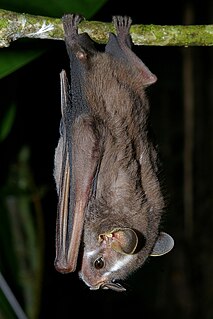 W
WHeller's broad-nosed bat is a bat species from South and Central America.
 W
WThe Irrawaddy dolphin is a euryhaline species of oceanic dolphin found in discontinuous subpopulations near sea coasts and in estuaries and rivers in parts of the Bay of Bengal and Southeast Asia.
 W
WThe Japanese sea lion was an aquatic mammal thought to have become extinct in the 1970s. It was considered to be a subspecies of California sea lion until 2003. They inhabited the Sea of Japan, especially around the coastal areas of the Japanese Archipelago and the Korean Peninsula. They generally bred on sandy beaches which were open and flat, but sometimes in rocky areas. They were hunted commercially in the 1900s, leading to their extinction.
 W
WThe Juan Fernández fur seal is the second smallest of the fur seals, second only to the Galápagos fur seal. They are found only on the Pacific Coast of South America, more specifically on the Juan Fernández Islands and the Desventuradas Islands. There is still much that is unknown about this species. Scientists still do not know the average life span of this species, or the diet and behavior of males apart from the breeding season.
 W
WThe little yellow bat is a species of vesper bat found only in Mexico.
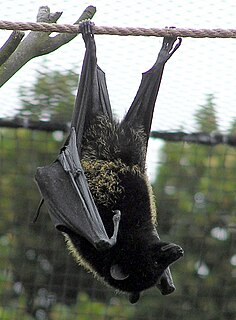 W
WLivingstone's fruit bat, also called the Comoro flying fox, is a megabat in the genus Pteropus. It is an Old World fruit bat found only in the Anjouan and Mohéli islands in the Union of the Comoros in the western Indian Ocean.
 W
WThe long-legged myotis is a species of vesper bat that can be found in western Canada, Mexico, and the western United States.
 W
WThe Madagascan fruit bat is a species of bat in the family Pteropodidae. It is endemic to Madagascar and is listed as "Vulnerable" by the IUCN because it is hunted as bushmeat.
 W
WThe Mexican spider monkey, is a subspecies of Geoffroy's spider monkey, a type of New World monkey, from Mexico and Central America, native to Mexico, Guatemala, Honduras, Nicaragua and El Salvador. It is described as being critically endangered by the IUCN, due to an 80% population decline in the last 45 years, mostly due to a large amount of habitat loss.
 W
WThe northern elephant seal is one of two species of elephant seal. It is a member of the family Phocidae. Elephant seals derive their name from their great size and from the male's large proboscis, which is used in making extraordinarily loud roaring noises, especially during the mating competition. Sexual dimorphism in size is great. Correspondingly, the mating system is highly polygynous; a successful male is able to impregnate up to 50 females in one season.
 W
WThe Nubian wild ass is the nominate subspecies of African wild ass, and one of the ancestors of the domestic donkey, which was domesticated about 6,000 years ago. It is presumed to be extinct, though two populations potentially survive on the Caribbean island of Bonaire and in Gebel Elba.
 W
WThe ornate titi is a species of titi and is the smallest member of the family Pitheciidae, which also includes uakaris and saki monkeys. As it is a member of this family, it is classified as a type of New World monkey. It is endemic to eastern Colombia, and the only member of the Plecturocebus moloch group to occur north of the Rios Amazonas/Solimes/Napo axis, living at least 350 km away from the closest other member, the white-tailed titi, which lives in the south of Colombia. It was once classified as the same species as the white-tailed titi, but is now officially recognized as its own species. The ornate titi is also terrestrial.
 W
WOzimops planiceps is a small bat in the family Molossidae, native to Australia and Indonesia.
 W
WThe Père David's deer, also known as the milu or elaphure, is a species of deer native to the river valleys of China. It grazes mainly on grass and aquatic plants. It is the only extant member of the genus Elaphurus. Based on genetic comparisons, Père David's deer is closely related to the deer of the genus Cervus, leading many experts to suggest merging Elaphurus into Cervus, or demoting Elaphurus to a subgenus of Cervus.
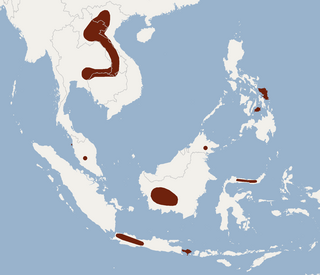 W
WPeters' trumpet-eared bat is a species of bat in the family Vespertilionidae, the vesper bats. It is native to Indonesia, Laos, Malaysia, Vietnam, and the Philippines. It was named by Peters for Fedor Jagor. It is also known as the common trumpet-eared bat.
 W
WThe pygmy round-eared bat is a bat species from South and Central America.
 W
WRüppell's or the greater broad-nosed bat is a species of vespertilionid microbat found in eastern Australia.
 W
WThe short-furred dasyure, also known as the short-haired marsupial mouse, is a member of the order Dasyuromorphia. It was once recognised as the only species in the genus Murexia, but now five species are recognised. It lives in Papua, Indonesia and Papua New Guinea.
 W
WThe Sierra de Perijá white-fronted capuchin is a species of gracile capuchin monkey from Colombia and Venezuela. It had formerly been regarded as a subspecies of the Humboldt's white-fronted capuchin but was reclassified by Mittermeier and Rylands as a separate species in 2013, based on genetic studies by Jean Boubli.
 W
WThe southern big-eared brown bat is a species of bat from the family Vespertilionidae. Although current taxonomy treats the southern big-eared brown bat as a separate species, it is often treated as a subspecies of the small big-eared brown bat. It lives in the forests of southern Argentina and Chile; though the population of the bat in the southern part of its habitat is low, there are no major concerns to justify anything lower than a Least Concern rating in the IUCN Red List. There is some habitat destruction, as well as trouble with beavers in Tierra del Fuego.
 W
WThe southern dog-faced bat, is a Central and South American bat species of the family Molossidae. It is found in northern Argentina, Bolivia, Brazil, Colombia, French Guiana, Guyana, Panama, Peru, Paraguay, Suriname and Venezuela.
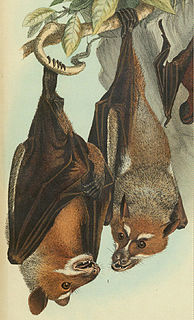 W
WThe Wallace's or Sulawesi stripe-faced fruit bat is a species of megabat in the family Pteropodidae. It is endemic to Sulawesi and the nearby Togian Islands of Indonesia. Cave paintings resembling these bats have been found in Australia, where bats of this kind are not otherwise known.
 W
WThe tent-making bat is an American leaf-nosed bat (Phyllostomidae) found in lowland forests of Central and South America. This medium-sized bat has a gray coat with a pale white stripe running down the middle of the back. Its face is characterized by a fleshy noseleaf and four white stripes. Primarily a frugivore, it may supplement its diet with insects, flower parts, pollen, and nectar. Its common name comes from its curious behavior of constructing tents out of large, fan-shaped leaves. These roosts provide excellent protection from the tropical rains, and a single tent roost may house several bats at once. This bat is quite common in its geographic range; hence, its conservation status is listed as Least Concern.
 W
WWelwitsch's bat also known as Welwitsch's mouse-eared bat or Welwitsch's myotis is a species of vesper bat native to Africa.
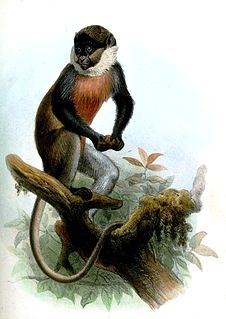 W
WThe white-throated guenon, also known as the red-bellied monkey and the red-bellied guenon, is a diurnal primate that lives on trees of rainforests or tropical areas of Nigeria and Benin.